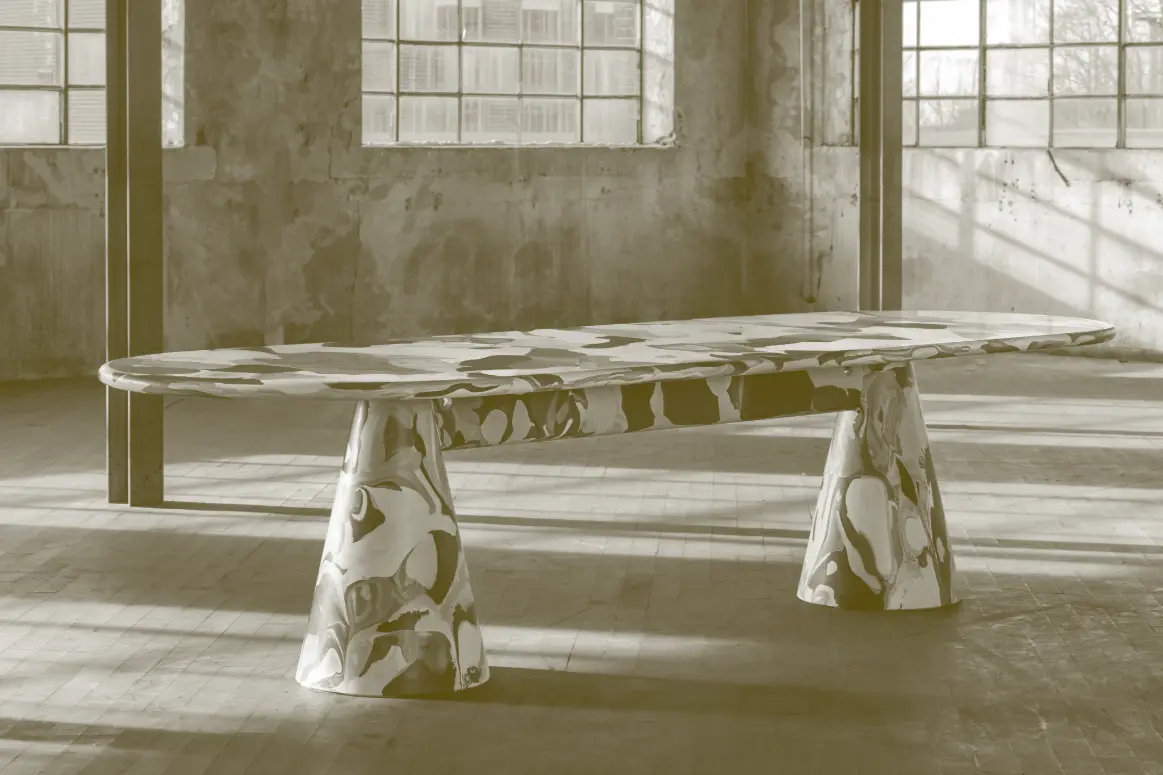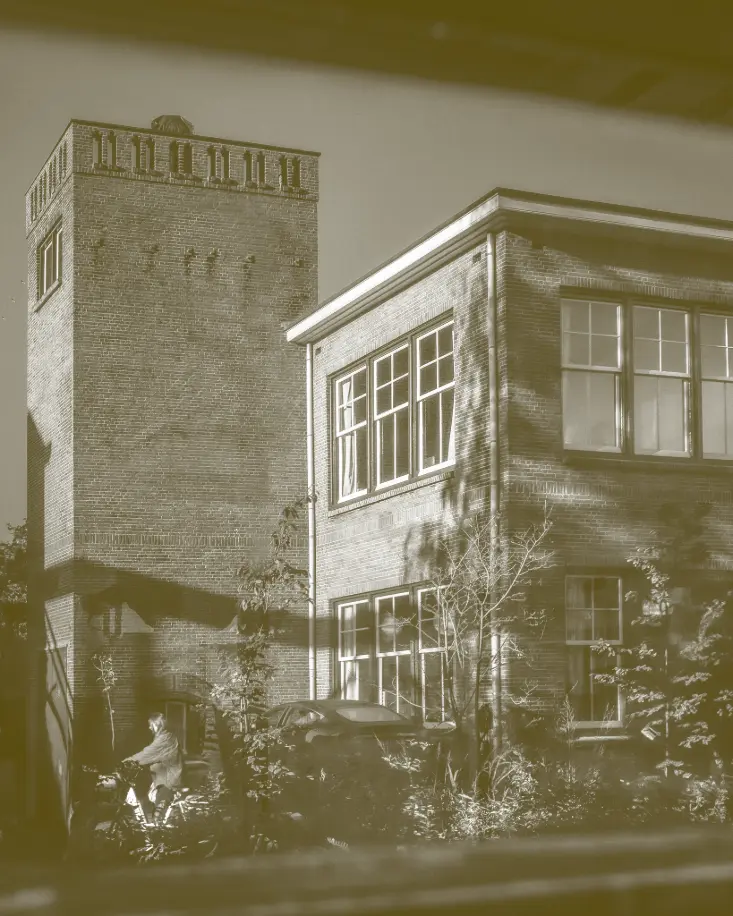STORY
Dirk van der Kooij is embracing unlikely materials, process-first.

A Meltingpot table in the Kooij workshop in Zaandam. The 1920s ammunition warehouse represents a new chapter for the studio, offering much-needed space for experimentation & machinery.
PLASTIC IN THE HANDS OF A CARPENTER
Dirk van der Kooij was a carpenter: as a young boy, he recalls sitting in church with his attention set on the wooden pews rather than the divine. At age 12, his father had directed this interest to a local woodworker, who patiently took on her young apprentice. Dirk would sell his creations to pay for tools—a chair sold, a chair made.
Amsterdam's beloved Wood & Furniture School further refined his passion, but also introduced an essential conflict. At the time, commercial woodworking relied heavily on chipboard and veneer. A materialist at heart, Dirk was compelled to continue his search for abundant (yet honest) material sources.
It was during his time at the Design Academy Eindhoven that Dirk first began to interrogate recycled plastic. Could this waste material fulfil his yearning for a solid, expressive, sustainable alternative to wood?
"I was hoping to find a material to offset feelings of guilt about making—using waste material felt like a very logical answer."

Founder Dirk van der Kooij with his self-built robotic extruder. His first studio space was hardly bigger than the robot itself. Photo credit to Delfino Cisto Legnani
"I was hoping to find a material to offset feelings of guilt about making—using waste material felt like a very logical answer."

Founder Dirk van der Kooij with his self-built robotic extruder. His first studio space was hardly bigger than the robot itself.
A Meltingpot table in the Kooij workshop in Zaandam. The 1920s ammunition warehouse represents a new chapter for the studio, offering much-needed space for experimentation & machinery.

WASTE REIMAGINED
More than a decade since the first Endless Chair, the Kooij collection has expanded to include lighting, tables, vessels, and seating. Generating value for waste, be it through textural or practical applications, is the driving force behind many of the
The studio generates values for 40T of waste plastic a year, shaping this problem material into its final form. Dirk van der Kooij uses design to break the waste cycle. By creating value and purpose for recycled plastic, he ensures that this problem material is preserved safely—and at scale. The studio is responsible for giving shape to over 40T of waste plastic a year. By crafting discarded plastic into heirloom furniture, it needn’t ever return to the environment as waste.ed this interest to a local woodworker, who patiently took on her young apprentice. Dirk would sell his creations to pay for tools—a chair sold, a chair made.
Amsterdam's beloved Wood & Furniture School further refined his passion, but also introduced an essential conflict. At the time, commercial woodworking relied heavily on chipboard and veneer. A materialist at heart, Dirk was compelled to continue his search for abundant (yet honest) material sources.
It was during his time at the Design Academy Eindhoven that Dirk first began to interrogate recycled plastic. Could this waste material fulfil his yearning for a solid, expressive, sustainable alternative for wood?
There is no manual for working with recycled plastic. Without a clear path forward, Dirk was left to develop his own machines. Imperfect, improvised, and low-cost, these tools would shape the visual identity of the work that followed. Through creating a distinct language of machine, plastic, too, would find a voice of its own.
Dirk's earliest experiments in plastic, the Elephant Skin, were the result of cooling reheated material outside of a mould. The heating chamber comprised several pizza ovens welded together. Under these haphazard conditions, the material would wrinkle and contract spontaneously, creating a living tactility.
Yearning for additive processes, Dirk soon set about reconfiguring a robotic arm from the auto industry. Several electric shocks and a full year later, the Endless Chair was born of the world's first plastic extruding robot. A misaligned motor would impart a distinct scalloped patterning, gifting an endearing, faintly familiar texture to plastic.
FORM FOLLOWS PROCESS
"I was hoping to find a material to offset feelings of guilt about making—using waste material felt like a very logical answer."
FORM FOLLOWS PROCESS
There is no manual for working with recycled plastic. Without a clear path forward, Dirk was left to develop his own machines. Imperfect, improvised, and low-cost, these tools would shape the visual identity of the work that followed. Through creating a distinct language of machine, plastic, too, would find a voice of its own.
Dirk's earliest experiments in plastic, the Elephant Skin, were the result of cooling reheated material outside of a mould. The heating chamber comprised several pizza ovens welded together. Under these haphazard conditions, the material would wrinkle and contract spontaneously, creating a living tactility.
Yearning for additive processes, Dirk soon set about reconfiguring a robotic arm from the auto industry. Several electric shocks and a full year later, the Endless Chair was born of the world's first plastic extruding robot. A misaligned motor would impart a distinct scalloped patterning, gifting an endearing, faintly familiar texture to plastic.

Founder Dirk van der Kooij with his self-built robotic extruder. His first studio space was hardly bigger than the robot itself. Photo credit to Delfino Cisto Legnani
"I was hoping to find a material to offset feelings of guilt about making—using waste material felt like a very logical answer."
